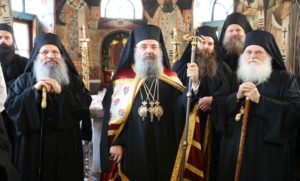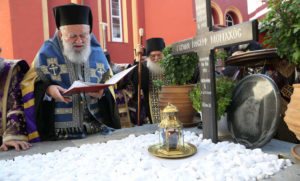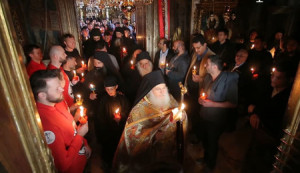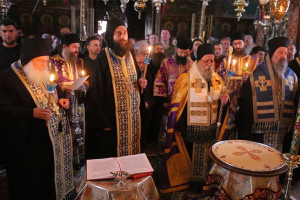ათონის აკადემია “ათონიადა “
24 November 2011A presentation at the two-day conference held in Athens on 11-12 December 1999 entitled ‘The Athoniada Academy: 250 years since its establishment’.
A monk’s ascetic life is experienced in three different ways.
The first has to do with the hesychastic life like the one Saint Anthony (late 3rd – early 4th c.) pioneered. According to this way of life, the ascetic lives totally isolated, practicing fasting, all-night vigils and prayer in order to communicate with the ‘divine’, intentionally cutting himself off from people. However, he assists everyone with his prayers, something which verifies his friendship with the Lord.
The second way is a mild form of the hesychastic life, where three to six people live in an ascetic setting, assisting each other and other people with their prayers; they also have some limited ability to offer hospitality. This is the so-called life in a skete or cells.
The third way of the monastic experience is the one which takes place in small or large coenobia, numbering twenty at the Holy Mountain.
One such monastery is the Holy Great Monastery of Vatopaidi. It is traditionally believed to have been established by Theodosius the Great and his son, Arcadius. By the end of the tenth century, manuscripts have been found which are signed by the first Abbot, Saint Nicholas.
The visitor to the monastery will be able to follow the traces which ten centuries have left on the byzantine and post-byzantine architecture, on the frescoes, the sculptures, the rare icons and the wall paintings, the unique to the Holy Mountain byzantine mosaics, the brocades, small sculptures as well as on exquisite manuscripts.
The various everyday activities are wonderfully depicted in more than 350,000 manuscripts. These are byzantine and post-byzantine, Modern Greek, Slavonic and Turkish and refer to emperors, rulers, patriarchs and head priests as well as to everyday mundane needs.
In the monasteries monks spend a great deal of time in liturgies; that is, in prayer. They spend less time in diakonia, namely working. It is traditional that the monasteries offer hospitality to most visitors/ worshipers who arrive at the Holy Mountain. The various emperors used to describe Vatopaidi as a ‘populous’ monastery because it had many monks who lived inside the compound but also in Sketes and cells and in other nearby hesychastic places.
Many, renowned personalities used to visit the monastery and offer gifts, as it is manifested in the various documents, inscriptions and relics. Despite the monastery booming in art and culture, it managed to preserve its traditional hesychastic way of life. Even during the 14th century, regarded as the golden age of art, various personalities live inside and outside the monastery like St Gregory Palamas, St Filotheos Kokkinos, who was the Elder of St Nicodemus the Hesychast, and later on became Patriarch of Constantinople, and St Sava, the ‘dia Christon salos’ (‘full for Christ’). In those days, orthodox theology has developed enormously because these monks had acquired the divine illumination and the experience of deification through their orthodox monastic practice. In addition, since they were scholars, they also had the skill to convey their experiences in writing.
Earlier, Emperor St Symeon and his son, St Savva, who became the first archbishop and the enlightener of Serbia, were tonsured and lived at Vatopaidi. Similarly many people belonging to the renowned families of Palaiologos and Kantakouzinos became monks.
As a result, from the time the monastery was established up to a century before the fall of Constantinople to the Turks, Emperors offered plenty of gifts to Vatopaidi. The Serb rulers have also remained benefactors. Pious aristocrats have always shown a preference for Vatopaidi, e.g. the high ranking militia men Georghios Astras in 1359, Manassis Tarhaniotis and Alexios Laskaris.
By the turbulent 1420s, ties with high society continued. At the same time there was a spiritual renaissance. According to the professor of History, Nikos Economides, when Thessaloniki was captured by the Turks in 1430 the Great Holy Monastery of Vatopaidi preserved its principal position among the monastic communities in Mount Athos. “It continued to receive gifts by the aristocracy, especially from Serbia and sustained its relationship with Constantinople. The Emperor was borrowing any books he could not find in Constantinople and had requested the representation of the monastery at the Ferrara-Florence Synod (1437-1439). Thereafter, however, life in the monastery came under a new status, since the Turkish occupation of Greece took hold and lasted almost five centuries.
During the first years of the Turkish occupation and the new statehood legalities, the monastery adapted and grew with some difficulty. The historian Kriton Chrysohoides says: “Despite the financial difficulties and the reduction in its assets because of the new state of affairs, Vatopaidi managed to carry on as a great and important monastic institution with discernible clout compared to other Athonite monasteries. This became evident by the abundance of metochia (dependencies) gifted to the monastery and by the great number of high ranking clerics who were directly dependent on the monastery. The annexation of various monasteries to Vatopaidi as dependencies by their owners or their restorers was always motivated by the need to ensure the survival of the particular institution. This means that in their minds Vatopaidi was an establishment which could safeguard their survival and growth”.
From the mid 15-16th Centuries and even later, an extraordinarily large number of archbishops seems to be directly associated with the monastery. Distinguished members of the brotherhood became archbishops and even rose to the Patriarchate throne.
Moreover, in the beginning of the 16th Century the scholar St Maximus the Greek, chooses Vatopaidi as his base and from there he launches his ministerial mission throughout Greece before ending up in Russia. There he carried out such a varied and remarkable mission in civilizing the Russians that he was described as “the enlightener of Russia”. In 1527, the scholar metropolitan of Thessaloniki retired to the monastery. He left his mark on the community and this is attested by an abundance of brilliant manuscripts which he gifted to the library and which prove his literary standing.
It is obvious therefore, that during the Byzantine period, Vatopaidi became famous as the monastery of the gentile and the emperors. In the post Byzantine era it becomes the monastery of the scholars and the clergy of the Eastern Orthodox Church.
Since the 16th Century a new era begins which is defined by a definite economic and spiritual renaissance with strong national and spiritual implications which led to the revolution of 1821. To begin with, Russian Emperors strengthened Vatopaidi. Then Moldovan rulers gifted an impressive number of dependencies. The reason for these annexations was to assist financially the monasteries which gave the gifts, or to establish new coenobiums with the Vatopaidi monks, which numbered between 350 -400 at the time.
Scholar monks with active personalities became bishops and launched a spiritual and national mission around the various depndencies. They would later acquire the title of the Bishop of Vatopaidi and Erinoupoleos. Thus Vatopaidi would assist any spiritual mission relating to the nation and Orthodoxy.
Under this spiritual and economic stoutness and the auspices of personalities with great influence in Russia, Constantinople and Moldova, Vatopaidi decided to take a further step in helping the nation by preparing scholars who would stir the Greek conscience by spreading the knowledge and the deep spiritual experiences which Orthodoxy nurtures.
Therefore, the establishment of the Athoniada School in 1749 was the highlight of Vatopaidi’s spiritual presence. The school was established at the instigation of several monks and especially of Meletios of Vatopaidi and had implications which transcended the boundaries of Mount Athos.
The policies which the Turks employed to assimilate the occupied nations are well known. Therefore, the Greeks were in danger not only of losing their national conscience but also their religion, Orthodoxy. During the first few years of the Turkish occupation, the Church tried to establish schools with every available means. The clergy understood that education and the study of the scriptures constitute a source of wisdom. This was unfortunately almost extinguished because Greek schools were persecuted at whim, even though some managed to survive. e.g. the Evangelical School of Smyrna, the School of the Cross in Jerusalem, Patmiada School in Patmos, the Pancyprian Gymnasium in Nicosia, the Maroutsea School in Ioannina and a few others.
Athoniada was established on a hill opposite the monastery of Vatopaidi. Soon it became so well known that as Sergios Makraios says ‘never such a school existed for the unfortunate Greeks’.
As the official charter issued by the Patriarchate says: it was ‘an institution teaching Greek and all subjects in the faculties of science, philosophy and theology’. It was not just a school of theology as one might gather from the place in which it was established and from the kind of people who first captured and materialized the idea, but a small university ‘teaching all subjects’. The fact that the objective of Meletios and those who first conceived the idea, was to establish an institution with reputation exceeding the Greek frontier into the Balkans is established by the following:
1. The operations launched to establish and maintain the institution spread throughout the nation, both in the Turkish occupied areas and among the Greek communities abroad. Such was the scale of the operation that committees were set up in 150 cities worldwide with the task to collect money to assist the institution.
2. Renowned personalities throughout Europe and the Ottoman Empire- scholars from distinguished institutions gave up their seats to teach at the Athoniada School.
3. The structure was larger than most hagiorite monasteries and there was an equally large aqueduct.
4. The Ecumenical Patriarchate at the request of Vatopaidi became actively and vigorously involved.
Excerpts from the book ″Athonite Word″ by Archim. Ephraim of Vatopedi, Abbot of Holy and Great Monastery of Vatopaidi.
Translated by Olga Konari Kokkinou from the Greek edition: Αρχιμ. Εφραίμ Βατοπαιδινού Καθηγουμένου Ι.Μ.Μ. Βατοπαιδίου, Αθωνικός Λόγος, Ιερά Μεγίστη Μονή Βατοπαιδίου, Άγιον Όρος 2010






